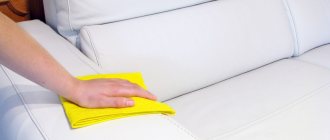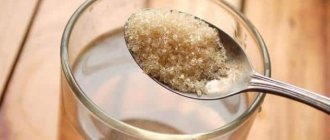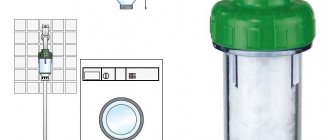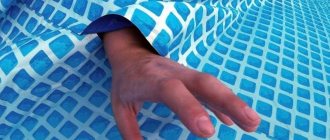Water is a favorable environment for the habitat and reproduction of various bacteria. That is why you need to regularly clean and disinfect it so that you can feel comfortable when swimming and not worry about harming your body. Currently, there are a huge number of cleaning and disinfection methods that are used both at dachas (we’ll talk about how to do everything with your own hands, without involving specialists, below - editor’s note) and in water complexes.
What do you need to get rid of?
Every day, a variety of contaminants enter the pool from the environment with precipitation or wind (if the pool is open) or through windows, doors and the ventilation system (if it is closed). In addition, particles of keratinized skin, decorative cosmetics, foundation or tanning creams are a breeding ground for bacteria. Against this background, the water quickly loses transparency, becomes cloudy and has a green color due to the presence of algae. For this reason, microbes multiply, and a white coating appears on the walls of the pool, which looks unpleasant. You should get rid of this using means, of which there are a large number.
Electrophysical disinfection
If the use of chemicals is fundamentally impossible, then to combat microbes you can resort to a more expensive method - purchasing electric disinfectors.
They come in three types: ionizers (working on the basis of silver or copper), UV emitters and devices that carry out ozonation. Like chemical compounds, disinfectants can completely remove all harmful organisms from water.
In order to clean the pool, there is no need to resort to the expensive services of specialized organizations. It is quite possible to do this yourself. However, this will require free time and significant financial costs.
What methods are usually used?
To choose a cleaning and disinfection method, you need to consider several factors:
- Pool volume;
- The number of visitors for a specific time (if it is a public swimming pool);
- Indoor or outdoor swimming pool;
- The material from which the walls and stairs are made;
- Water hardness, because it affects the quality of processing and the solubility of substances;
- The time spent in the pool, because the amount of chemicals absorbed into the skin depends on this.
NOTE! Only with constant and comprehensive cleaning can you achieve clean water.
Water filtration
In addition to visible debris in the water, small particles always remain. Cleaning filters help remove them.
The entire range can be grouped as follows:
- diatomaceous earth plants,
- cartridge devices,
- sand and gravel cleaners.
The third option is considered the most budget-friendly equipment. However, its operation is not as effective as that of other devices. In addition, it requires periodic replacement. So the benefit from its acquisition is doubtful.
Diatomaceous earth filters are considered the most technologically advanced, but their price is quite high. Therefore, most often in modern swimming pools you can find cartridge devices. They do their job perfectly and are also quite inexpensive.
If necessary, there is no need to completely change them; you can replace only one cartridge and continue to use the filter.
Chemistry
Zelenka
Zelenka is a folk remedy for disinfecting (we'll talk about other liquids below) and cleaning the pool. In order to clean the pool, you need to add 1 bottle of brilliant green to 1 bucket of water. After the water turns blue, it needs to be poured into the pool.
Copper sulfate
Copper sulfate prevents water cloudiness and the formation of algae. You should wear gloves before using it. The dosage depends on the purpose and frequency of pool cleaning. To purify water per 1000 liters you need 0.3 g, and for disinfection - up to 0.9 g.
White
Whiteness is a folk remedy. It's bleach. Before using it, you need to add chlorine to the water to stabilize the pH level (a measure of activity (in very dilute solutions it is equivalent to concentration) - editor's note). After swimming in a pool treated with white, you must take a shower, and while in the water, it is not recommended to rub your eyes or swallow water. If you have allergic reactions to certain white substances, you should avoid swimming in such a pool.
Pool mushroom
There are special pool products that allow disinfection. They are a mushroom-shaped dispenser float into which tablets are placed and lowered into the pool. The dosage is one tablet (20 g) per 3-10 cubic meters of water.
Potassium permangantsovka
You can use potassium permanganate, but this will not give a long-lasting effect. If the pool is made of PVC materials, then it will definitely darken after applying potassium permanganate. And because of this, you need to add ascorbic acid to decolorize the water, which will also darken.
Salt
When adding salt for pools, you need to control its concentration (2.5-3 ppm).
Drugs
Algaecide preparations are actively used in pool cleaning. They allow you to get rid of silt (soft rock made from a mixture of mineral and organic substances, deposited at the bottom of watercourses and reservoirs - editor's note) and algae. Before starting treatment, you need to chlorinate the water, control the pH level using reagents or instruments, and then you need to add 0.4 liters of the drug to 10 cubic meters of water.
In addition, we use coagulants - agents that glue suspended particles, which cause cloudiness in the water.
Perhydrol
Perhydrol is hydrogen peroxide, which has a high concentration.
IMPORTANT: after using this product, swimming in the pool is prohibited for 24 hours.
More details here: Perhydrol for pool cleaning
The dosage of perhydrol depends on the concentration. If perhydrol is 37%, then with old water per 1000 liters of water you need to add 1200-1400 ml of water, and if the substance is 60%, then 700 - 900 ml.
Maintaining acceptable acid-base balance
An acceptable balance is 7.2 – 7.4, not 5.5. It is necessary to remember this and diligently maintain the required regime in the water.
Analysis of the water that fills the pool can be carried out using special chemical reagents. Any of them is freely available, each of them is accompanied by mandatory instructions.
If you have doubts about the use of reagents, it is worth remembering that they are the ones who guarantee the normal use of the water filtration system, its lighting and heating systems.
And an acceptable acid-base balance improves the quality of the effects of chemicals used in the process of water purification.
For example, today it is recommended to purchase special pumps for cleaning, with additional containers installed inside, filled with the necessary coagulant, which guarantees normalization of the pH level.
It is better to purchase just such filters, although their cost is somewhat higher. But the benefits from their influence are incomparably greater.
Let's compare all the methods with each other
| Means | pros | Minuses |
| Zelenka |
|
|
| Copper sulfate |
|
|
| White |
|
|
| Pool mushroom |
|
|
| Potassium permangantsovka |
|
|
| Salt |
|
|
| Drugs |
|
|
| Perhydrol |
|
|
Pool care chemicals
There are always two main preparations - for disinfection and for combating algae. At the same time, they enhance each other’s effect. Using only one product, for example Chloritex (without adding Algitin), you will soon see that the water begins to turn green.
Pool granules Markopul-Chemicals Chloritex
For disinfection, it is convenient to use preparations in tablets and a special dispenser (another option is to first dissolve the product in a bucket). Decide what drugs you will use - chlorine or oxygen. Oxygen is somewhat more expensive, but less effective (their effect is short-lived, so you will have to add more often) and cause a change in the color of ferrous water if a demetallizer is not added to it first. But oxygen does not irritate the skin and mucous membranes and has no odor. Complex preparations (for example, Chloroxone) occupy an intermediate position between chlorine and oxygen in properties.
The most affordable chlorine-containing disinfectants (Chloriclar, Longafor, Chloritex, Chloroxone, etc.). They are effective against many bacteria and algae spores. However, bleach has many disadvantages: it has an unpleasant, pungent odor, dries the skin, irritates the mucous membranes of the eyes, and sometimes causes the formation of foam. In addition, chlorine-containing preparations do not act on some persistent (and very dangerous) rod bacteria, so experts recommend adding potassium permanganate (potassium permanganate) to the water at the rate of approximately 1 g per 0.5 m3.
Filters
Filters are a mechanical cleaning method. Thanks to them, you can remove small particles and clean all layers of pool water. It should be remembered that the filter must be selected taking into account that it has time to pass water through itself 2-3 times per day.
They need to be washed once every 10 days, and cleaned several times a year. Installation of filters should be carried out by a specialist.
There are many types of filters, each of which has pros and cons.
| Filter | pros | Minuses |
| Sand |
|
|
| Diatomaceous earth |
|
|
| Cartridge |
|
|
More details about filters: Filters
How to clean the water in an inflatable pool
Special products will help clean the walls of the inflatable pool from dirt.
The most common type of pool among summer residents is an inflatable, small one. It is convenient and easy to use, but requires frequent water changes.
If your pool is small, the best way to clean the water is to change it completely. To do this you will need to do the following:
- Drain the contaminated water.
- Thoroughly clean the walls with the chosen product.
- Treat the internal surfaces with protective compounds, which are often sold complete with inflatable pools.
For larger pools, maintenance comes down to disinfection, removing dirt and clearing the walls of mucus. It is necessary to add a disinfectant once a week.
other methods
Silver ions
Thanks to ionization with non-ferrous metals, the need for water disinfection with chlorine can be reduced. There is no smell after cleaning. If a person has a large swimming pool, then it is recommended to use chlorine, which is a common method. Ionization systems do not combine well with other disinfection systems, and silver ions do not destroy all types of microbes. The effect of silver ions is that the ions interact with bacterial cells, metabolic disorders occur, and they die . However, it has now been proven that silver ions have a negative effect on the body.
Active oxygen
Active oxygen is very popular because it effectively and gently destroys bacteria and does not form harmful decay products. It is expensive and decomposes very quickly in water, which requires increasing the dose during subsequent purification. An overdose of this substance can lead to health problems. Active oxygen cannot be used in public or outdoor swimming pools. Warm pools with temperatures above 28 degrees are also not suitable for treatment, because oxidation slows down in warm water. After treatment there is no chlorine smell.
Ozonation
It is considered an environmentally friendly but expensive cleaning method. Used in addition to chlorination. Thanks to this method, the water is purified and also acquires a pleasant taste and smell. The water begins to acquire a blue tint and foam does not form. However, if high concentrations of ozone are inhaled, damage to the respiratory tract and lungs occurs. Pure ozone can explode and does not last long. When used correctly, ozone does not cause irritation to the skin, but in the environment it combines with air and is therefore neutralized. It is mainly used in large public swimming pools because it requires the installation of complex equipment. This cleaning system pays for itself in several years, because there is a saving in chemical costs.
In addition, you can use bromine or ultraviolet lamps.
Which is better: Chlorine or peroxide
- Peroxide, unlike chlorine, does not cause such severe harm to human health. Chlorine vapors can have a negative effect on human mucous membranes and irritate them.
- Chlorine is more effective. It cleans and disinfects much better and can even kill E. coli.
- Peroxide as an oxidizing agent is about 30% stronger than chlorine.
- Chlorine acts much faster, while peroxide acts for about two days.
So what is the best way to process it? The best solution in such a situation would be to alternate these funds.
Step-by-step instruction
Cleaning the pool is carried out in several steps:
- Preparation of funds. For mechanical cleaning, you need to purchase a net (what a net is is written here) to get rid of debris from the surface of the water, as well as a vacuum cleaner to clean the walls and bottom. You can purchase a brush or a skimmer, which is a tank that is installed in the wall of the pool. This device is used to collect the top layer of water, in which a large number of pathogenic microorganisms accumulate. If large particles of debris get into the skimmer, the filter traps them, and the purified water is sent for heating and then returned to the pool.
- Cleaning filters. To ensure that the water in the pool is always clean, the filters must be cleaned regularly. First you need to remove the contaminated part of the cartridge and rinse it under running water, and then dry it. When it is dry, it should be immersed for several days in a solution of water and chlorine, then rinsed with water and dried. The final step is to immerse it in a solution of water and hydrochloric acid until the bubbles stop. After washing them, you can insert them back.
- Removing garbage. Next, it is recommended to use a net to catch the debris and use a vacuum cleaner to go over all other surfaces.
- Disinfection. Disinfection of water in the pool should be carried out by some means (for example, one of the methods described above in this article - editor's note) taking into account all safety requirements, instructions for use and dosage.
IMPORTANT: In case of overdose, the body may be poisoned.
Cleaning the tank
So, we sorted out water purification. Next up is the second part of the article about cleaning the tank. There are much fewer options here and only mechanical methods are used. Since the walls and bottom of the tank are under water, it is difficult to reach them. Plus, it is necessary to carry out cleaning so as not to raise turbidity into the water. For this you need such devices.
- Here is a pool brush. A telescopic nozzle is put on it, which allows you to reach the walls and bottom of the tank. The disadvantage of this tool is that it picks up dirt from the day. Further water purification is carried out by filters, which indicates an additional and unnecessary load on them - the service life is reduced.
Pool brush
- Water purification using vacuum cleaners is much more effective, but such cleaning uses part of the water from the reservoir. A hose is connected to the outlet pipe on the brush, which is led outside the pool - dirty water will flow through it. Next, the brush is lowered into the water. Now you need to create a pressure difference by sucking water through the return end of the hose. As soon as the water flows, we begin cleaning - the dirt raised by the brush will be partially drawn in by the vacuum cleaner, and the water is drained through the hose.
Mechanical pool vacuum cleaner
- There is no water consumption here, although not all models have it. The device is equipped with an electric motor that draws water inside. It passes through a filter mesh in which debris particles of different sizes settle. The pump must operate under water.
Electric pool vacuum cleaner
- The most technically new method of tank cleaning will be a special robot. This baby has tracks or wheels and a complex sensor system that allows you to scan surfaces in the water. It can move both along the bottom and along the walls of the pool. Systematically and slowly, the robot vacuums the entire tank. A very funny toy that you can enjoy watching for hours.
Robot vacuum cleaner
There are also filters installed inside the robot that require periodic cleaning.
Product prices
Pool cleaning and disinfection products come in different price categories. You can calculate how much it costs to clean a swimming pool at your dacha using the table below:
| Means | Price |
| Zelenka | From 12 rub. |
| Copper sulfate | From RUR 19 (depending on volume) |
| White | From 20 r / 1 l |
| Pool mushroom MAC 4 mini | From 493 RUR |
| Potassium permangantsovka | From 49 RUR |
| Salt | From RUR 21 |
| Algaecide preparations | From RUR 3,169 |
| Perhydrol | From RUR 9,126 |
| Filters | From 110 rub. |
| Silver ions | From 34,000 rub. |
| Active oxygen | From RUR 1,149 |
| Ozonation | From RUB 275,500 |
You need to clean the water in the pool regularly to protect yourself, your family and your friends from getting unnecessary infections into your body. After trying all the cleaning methods described above, you can choose your own based on cost, ease of use and safety for others. It is important to know that some types of cleaning and disinfection are used only in large pools. For home use Jacuzzis, all chemical methods and filters are used. When using this or that disinfectant/device, it is recommended to fully study the instructions, as well as consult with a specialist in order to prevent possible unpleasant consequences in advance .
Mechanical cleaning
There are manual and automatic ways to carry out this procedure. The first option is longer and more labor-intensive, but the devices themselves are inexpensive. But the use of automation requires practically no labor costs, but the purchase of such equipment is associated with large expenses.
Pool cleaning kit
Removing surface debris is one of the mandatory steps that occurs at the very beginning of the procedure. This is the basic method for maintaining outdoor pools. The procedure begins with removing large debris (leaves, branches) and other visible particles.
To do this, use a net, which also allows you to catch most of the foam. After this, other simple devices are used. You can use various brushes to clean the walls and bottom of the pool.
The nozzle for processing corners looks like a brush.
The bristle material should be selected based on coverage. Models with plastic (propylene) and rubber bristles are suitable for cleaning inflatable tanks and vinyl bowls. Steel bristles are recommended for surfaces made of concrete and those finished with tiles or mosaics.
For the convenience of processing hard-to-reach places, telescopic rods are used.
The cleaning kit contains all the necessary equipment for manual pool cleaning. As a rule, it includes:
- garbage collection net,
- brush for washing the bowl,
- vacuum cleaner attachment for connection to the filter pump.
- Some kits include a thermometer to measure water temperature
- and a tester to determine its chemical composition (pH, chlorine level).
Vacuum cleaner for cleaning the pool
Underwater devices are also called bottom devices. Vacuum cleaners eliminate the possibility of accidental release of particles being removed into the water. They are retained in a filter pump or a special bag. This is the attractiveness of using such devices. There are 3 types of this unit:
Automated Pool Vacuum Cleaner
Robot vacuum cleaners are equipped with built-in filters. Such devices attract users with full autonomy, maneuverability and high power. This is the best product for maintaining large and deep pools. The entire apparatus, including the electrical part, is submerged under water. The vacuum cleaner moves independently, cleaning the bottom of the pool. Some models can be controlled using a remote control.
Semi-automated pool vacuum cleaner
The advantage of such devices is their versatility. They can be used to clean any pool. But there are also models designed for specific types of tanks. Semi-automatic devices usually need to be connected to a skimmer (filter). But there are also autonomous models that include a special garbage container. Such a vacuum cleaner can move automatically - in a spiral or describing a chaotic trajectory.
Handheld Pool Vacuum Cleaner
It is equipped with a hose, one end of which is connected to the brush and the other to the skimmer. Dirty water enters the filter, is cleaned and again discharged outside. Autonomous operation is not provided. Such a device is inexpensive, but it can only be used to process small structures. During operation of the equipment, the electrical mechanism remains on dry land.
Filtration units
They allow you to get rid of organic impurities and mechanical debris. The cleaning principle consists of flow passing through special nozzles. A properly selected installation will drain the entire contents of the tank every day, and do this repeatedly. The disadvantage of this method is that filtration kills bacteria, but not viruses.
The following types of filters are distinguished:
Cartridge
This system is easy to use and ensures thorough cleaning. The manufacturing materials are polyester and polypropylene. One filter can contain 3-4 cartridges designed for particles of 5 microns. Most of these devices are designed for single use. Once dirty, the old filter is usually thrown away and a new one installed. Only some models can be backwashed. The service life depends on the volume of the structure and is 3-12 months. For the system to work efficiently, it is necessary to have a supply of replacement cartridges.
Sand
Widely available but low-efficiency filters. They purify the water from impurities of iron and mineral salts, and remove sand settled at the bottom. The role of the filter material is performed by quartz sand, which traps particles larger than 20 microns. Can be used repeatedly, but require regular cleaning. They are cheaper than cartridge ones, so they are more popular.
Diatomaceous (another name is earthen)
Such filters are very effective, which explains their high cost. The device contains diatomaceous earth powder (sedimentary rock consisting of fossilized phytoplankton). Such filters capture particles down to 3-5 microns. They are designed for repeated use. Clogged systems must be cleaned using a special liquid product or backwash.
Along with the filtration unit, the pool must be equipped with a skimmer and pump.
The skimmer filters the surface layer of water. This device is a kind of pump that is built into the wall of the bowl. Large debris accumulates in the skimmer basket (coarse cleaning). After this, the pump directs the flow of water to the installation, which traps foreign microscopic particles. Purified clear water is fed back into the bowl through the circulation hose.
The main function of the pump is to prevent water stagnation. Microflora will actively develop in the immobile substance. It is not customary to change such devices frequently; they are installed for a long time. Ideally, they work throughout the entire period of operation of the pool.
The best DIY comprehensive cleaning methods
Such a wide variety of methods is associated not only with the effectiveness or cost of the procedures, but also with the operating conditions of the pool. The material of the reservoir, the nature of the pool - outdoor or indoors, the number of users - all this affects the frequency of cleaning and the choice of products.
For outdoor pool
Such a body of water is the most vulnerable. Good heating by the sun provides an environment for bacteria, open space literally attracts mechanical debris, the accumulation of organic matter - the same plant debris, promotes the rapid proliferation of algae. Therefore, it requires comprehensive cleaning.
On the other hand, the pool is located in the open air, so such a danger as the accumulation of reaction products after chlorination, for example, does not exist here. Therefore, all methods are used to clean open reservoirs.
- A combination of mechanical filtration with some chemical or electrophysical methods, without chemistry, is mandatory. The most affordable are cartridge or sand filter and chlorination.
- It is advisable to periodically carry out cleaning using coagulants: this is the best means for removing protein and fatty molecules that serve as food for both microorganisms and algae.
- In an outdoor pool, you need to constantly check the acidity level. With normal values of 7–7.4, the risk of algae infection is minimal. If the indicator deviates, the risk increases. The adjustment is made by adding “pH-plus” and “pH-minus” preparations to the water, respectively.
- It is not recommended to use ultraviolet disinfection, since quartz lamps, like any electrical device, should not be left in the open air for a long time.
Cleaning without chlorine
Chlorination is a simple and effective procedure. The only contraindication is an allergic reaction to chlorine dissolved in water. In this case, any other chemical methods are used, always in combination with mechanical ones:
- bromination;
- preparations with active oxygen;
- treatment with perhydrol solution.
If the pool is located indoors, the best method is ultraviolet disinfection or ionization.











